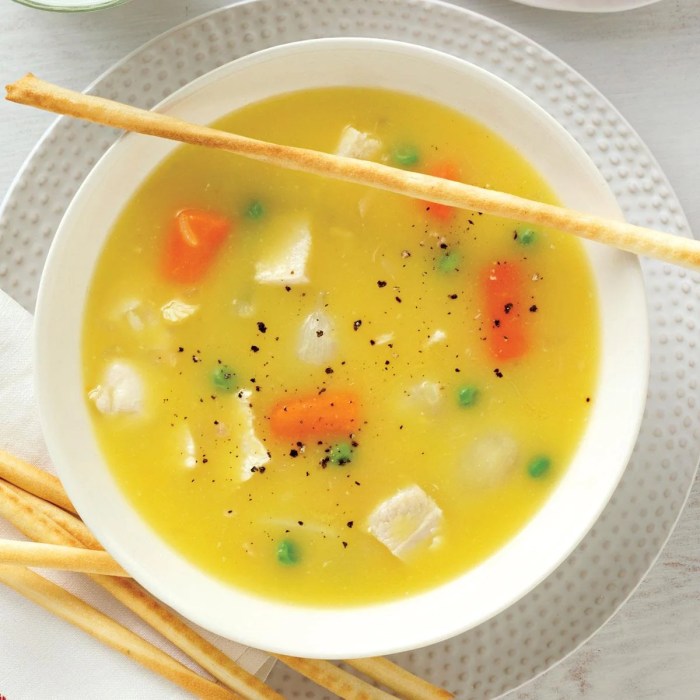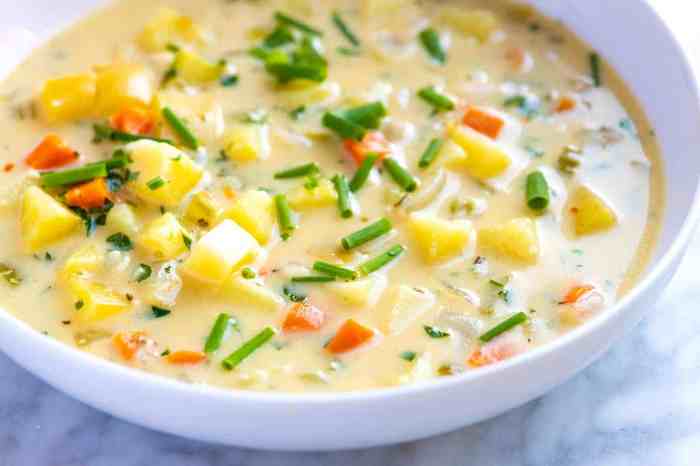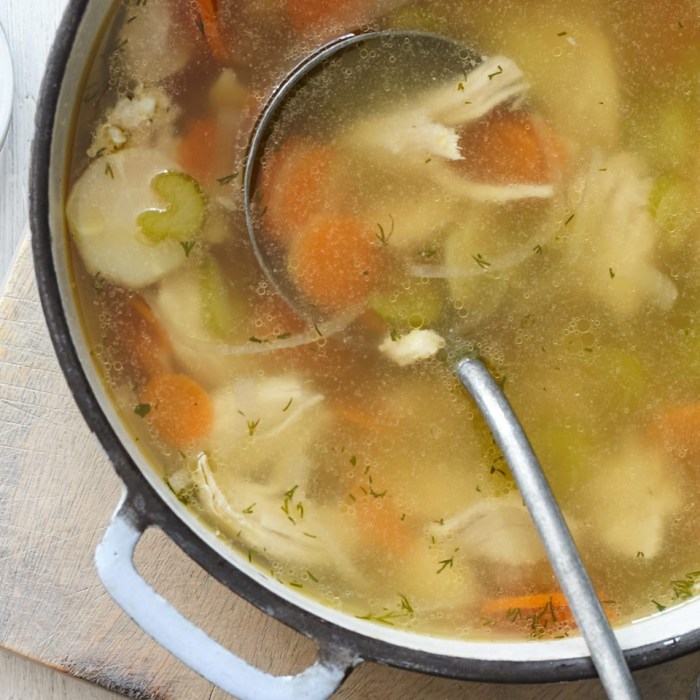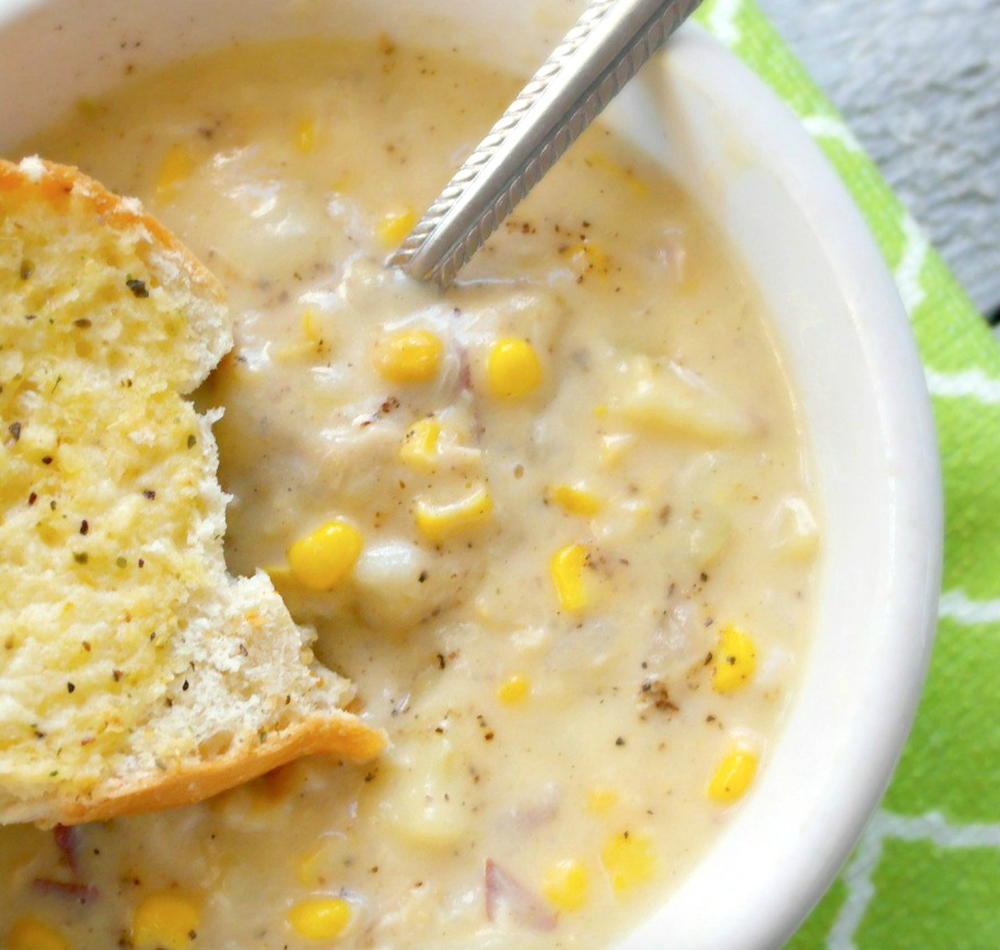Types of Soups
Recipes for soups – Soups, a culinary staple across cultures, offer a diverse range of flavors and textures. Categorizing soups helps in understanding their characteristics and variations.
Categorized Soup Types
The following table categorizes common soup types based on their key characteristics, ingredients, and serving suggestions.
| Type | Description | Common Ingredients | Serving Suggestions |
|---|---|---|---|
| Broth-Based | Clear, flavorful broths often featuring vegetables, meat, or poultry. | Chicken, beef, vegetables (carrots, celery, onions), herbs (parsley, thyme). | Appetizer, light meal, side dish. |
| Cream-Based | Rich and creamy soups, often thickened with cream, milk, or pureed vegetables. | Cream, milk, potatoes, cheese, vegetables (mushrooms, broccoli). | Main course, side dish, served with bread. |
| Chunky | Hearty soups with large, visible pieces of vegetables, meat, or beans. | Beans, lentils, vegetables (potatoes, carrots, tomatoes), meat (chicken, beef). | Main course, served with a side salad. |
| Bisque | A smooth, creamy soup, often made with shellfish or vegetables. | Shellfish (lobster, shrimp), vegetables (tomatoes, squash), cream. | Appetizer, main course. |
Regional Soup Variations
Regional variations showcase the unique culinary traditions and available ingredients.
- Broth-Based: French Onion Soup (France) uses caramelized onions as a base, while Pho (Vietnam) features a rich broth with herbs and noodles.
- Cream-Based: New England Clam Chowder (USA) uses clams and potatoes, while Potato and Leek Soup (UK) emphasizes leeks and potatoes.
- Chunky: Chicken Tortilla Soup (Mexico) incorporates tortilla strips and avocado, while Minestrone (Italy) is a vegetable-rich soup with pasta.
- Bisque: Crab Bisque (USA) features crab meat and sherry, while Tomato Bisque (France) uses roasted tomatoes and cream.
Soup Nutritional Profile Comparison
A visual comparison of three soup types (broth-based chicken soup, cream-based tomato soup, and chunky lentil soup) could use a bar graph. The x-axis would represent the soup types, and the y-axis would show nutritional values (calories, protein, fat, carbohydrates, fiber). Colors could be used to represent each nutrient. For example, chicken broth could be represented with light colors indicating lower calorie and fat content, while cream-based tomato soup might use richer colors for higher fat and calorie content.
Lentil soup might show a balance of colors representing protein and fiber.
Soup Recipe Ingredients: Recipes For Soups
Understanding the role of various ingredients is crucial for creating flavorful and textured soups.
Common Soup Ingredients
A wide array of ingredients contributes to the diverse world of soups. The following list categorizes common ingredients.
- Vegetables: Onions, carrots, celery, potatoes, tomatoes, garlic, leeks, mushrooms, spinach, etc.
- Proteins: Chicken, beef, pork, seafood, beans, lentils, tofu.
- Grains: Rice, barley, pasta, quinoa.
- Spices: Salt, pepper, cumin, coriander, paprika, turmeric, chili powder.
- Herbs: Parsley, thyme, rosemary, oregano, basil.
- Liquids: Water, broth, milk, cream, wine.
- Other: Butter, oil, lemon juice, Worcestershire sauce.
Ingredient Impact on Flavor and Texture
The choice of ingredients significantly impacts the soup’s flavor profile and texture. For instance, the addition of tomatoes provides acidity and sweetness, while the inclusion of beans adds heartiness and protein. The use of creamy ingredients like milk or coconut milk creates a richer texture, whereas the addition of starches like rice or potatoes provides thickness.
Fresh vs. Dried Herbs and Spices

Source: tmbi.com
Fresh and dried herbs and spices offer distinct flavor profiles and characteristics. Fresh herbs generally possess a brighter, more vibrant flavor, while dried herbs have a more concentrated and intense taste. Dried herbs are more convenient for storage but might require a longer simmering time to fully release their flavors.
Soup Making Techniques
Mastering basic techniques elevates homemade soups to a new level.
Making Vegetable Broth
A homemade vegetable broth forms the foundation for many delicious soups.
- Sauté chopped onions, carrots, and celery in olive oil until softened.
- Add water and vegetable scraps (onion peels, carrot tops, etc.).
- Bring to a boil, then reduce heat and simmer for at least 30 minutes.
- Strain the broth through a fine-mesh sieve.
- Season with salt and pepper to taste.
Thickening Soups, Recipes for soups
Several methods effectively thicken soups to achieve the desired consistency.
- Roux: A mixture of butter and flour cooked together until smooth.
- Cornstarch Slurry: Cornstarch mixed with cold water, then whisked into the simmering soup.
- Pureeing: Blending a portion of the soup to create a creamy texture.
Creamy Tomato Soup Flowchart
A flowchart for creamy tomato soup would start with roasting tomatoes, then moving to sautéing aromatics (onions, garlic). Next, the roasted tomatoes and aromatics would be simmered in broth. After simmering, the soup would be pureed, then cream or milk would be added. Finally, the soup would be seasoned and served. The flowchart could use rectangular boxes for steps, diamonds for decisions, and arrows to indicate flow.
Different colors could be used to represent different phases of the process, such as red for the tomato phase and cream for the cream addition phase.
Soup Recipe Variations & Adaptations

Source: inspiredtaste.net
Adapting basic recipes opens up a world of culinary creativity.
Chicken Noodle Soup Variations
A basic chicken noodle soup recipe can be easily adapted to create various flavor profiles.
- Spicy Chicken Noodle Soup: Add chili flakes, diced jalapeños, and a dash of hot sauce.
- Vegetarian Chicken Noodle Soup: Substitute chicken with mushrooms or chickpeas, and use vegetable broth.
- Low-Sodium Chicken Noodle Soup: Reduce or omit salt, and use low-sodium broth.
Ingredient Substitutions
Dietary restrictions or preferences often necessitate ingredient substitutions.
| Ingredient | Substitution |
|---|---|
| Chicken Broth | Vegetable Broth |
| Heavy Cream | Coconut Milk |
| Wheat Noodles | Gluten-Free Noodles |
Tips for Improving Soup Flavor and Texture
Several techniques enhance the overall quality of homemade soups.
- Sauté vegetables before adding them to the soup to enhance their flavor.
- Simmer soups for longer periods to allow flavors to meld.
- Taste and adjust seasoning throughout the cooking process.
- Use fresh herbs for a brighter flavor.
Serving and Presentation of Soups

Source: loveandlemons.com
Proper serving enhances the overall dining experience.
Soup Garnishes
Garnishes elevate the visual appeal and flavor of soups.
- Fresh herbs (parsley, chives, basil) add color and freshness.
- Croutons provide textural contrast and added flavor.
- A dollop of sour cream or crème fraîche adds richness and creaminess.
- Cheese (shredded cheddar, parmesan) adds savory notes and visual appeal.
- A drizzle of olive oil adds richness and visual interest.
Soup Presentation
The plating style and accompanying elements significantly impact the presentation.
Imagine three bowls: one with a vibrant tomato soup, garnished with fresh basil and a swirl of cream, served in a rustic bowl. Another bowl presents a creamy mushroom soup, topped with toasted croutons and a sprinkle of parmesan, elegantly served in a white porcelain bowl. The third bowl showcases a hearty lentil soup, garnished with chopped parsley and a lemon wedge, served in a simple, yet charming, stoneware bowl.
Serving Temperatures and Containers
Serving temperature and container choice depend on the soup type. Cream-based soups are best served warm, not hot, to prevent curdling. Chunky soups benefit from being served hot, in hearty bowls. Broth-based soups are best served hot in mugs or bowls.
Questions and Answers
Can I freeze leftover soup?
Yes, most soups freeze well. Allow the soup to cool completely before storing in airtight containers. Freezing time varies depending on the soup’s ingredients.
How long can homemade soup be stored in the refrigerator?
Homemade soup generally lasts 3-5 days in the refrigerator when stored properly in an airtight container.
What are some ways to add more flavor to my soup?
Consider adding a splash of acidity (lemon juice, vinegar), a touch of sweetness (maple syrup, honey), or a flavorful oil (truffle oil, chili oil) to enhance the depth of flavor.
How do I prevent my soup from becoming too salty?
Add salt gradually throughout the cooking process, tasting frequently. You can always add more, but you can’t take it away.


